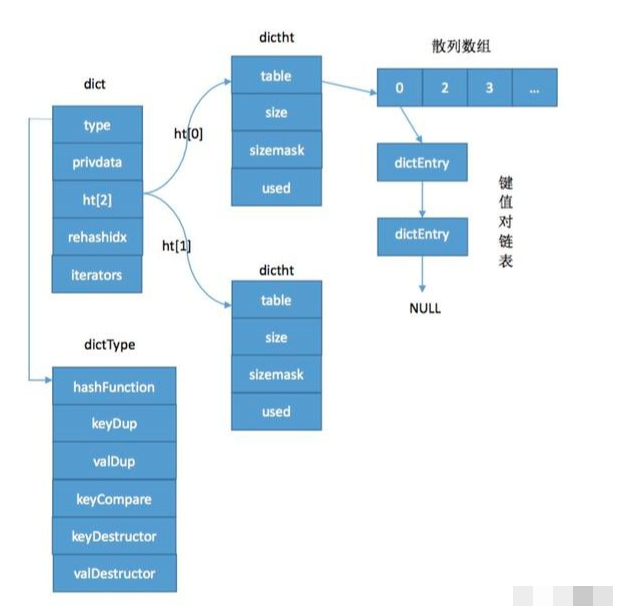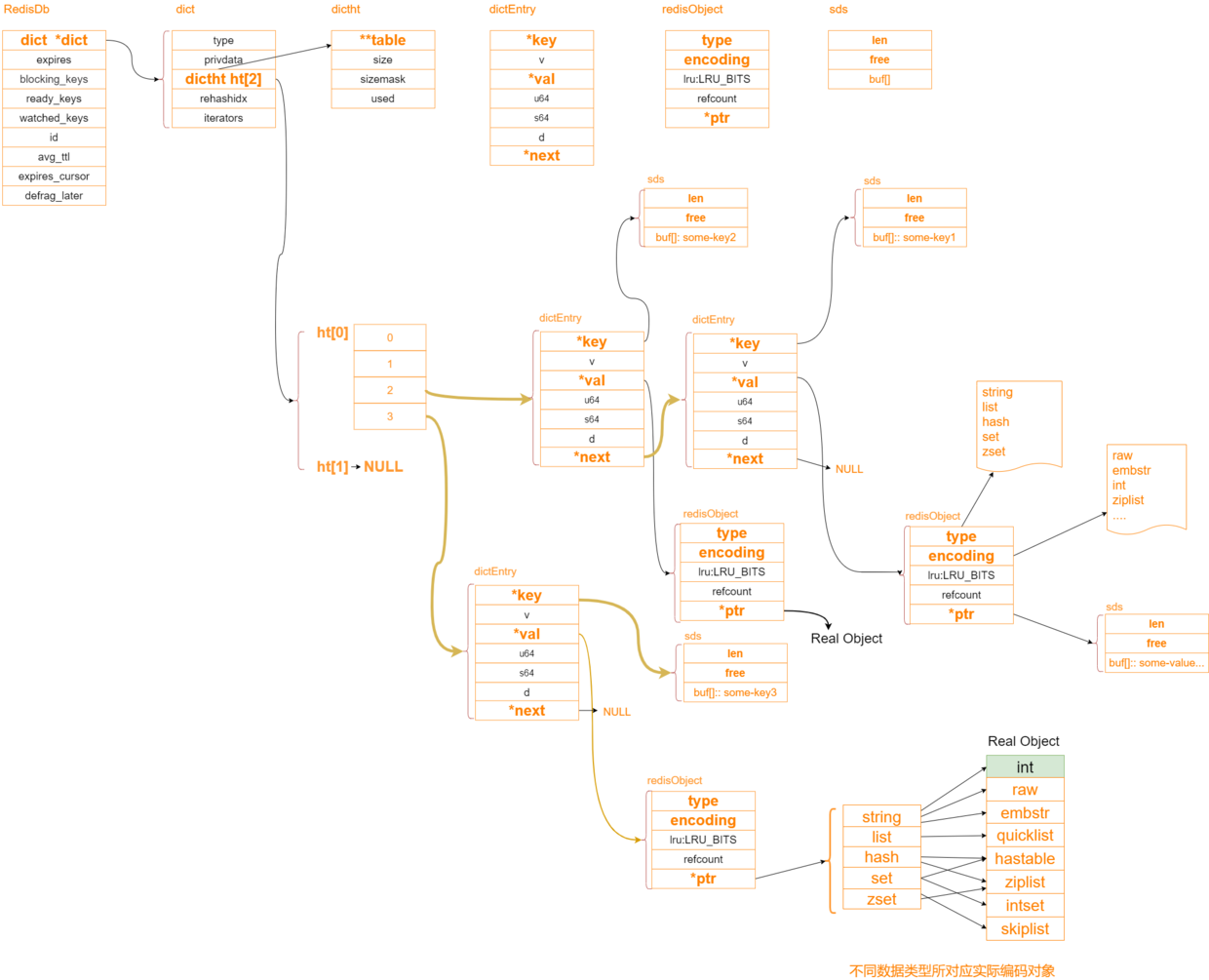大家都知道redis默认是16个db,但是这些db底层的设计结构是什么样的呢?
我们来简单的看一下源码,重要的字段都有所注释
typedef struct redisDb {
dict *dict; /* The keyspace for this DB 字典数据结构,非常重要*/
dict *expires; /* Timeout of keys with a timeout set 过期时间*/
dict *blocking_keys; /* Keys with clients waiting for data (BLPOP) list一些数据结构中用到的阻塞api*/
dict *ready_keys; /* Blocked keys that received a PUSH */
dict *watched_keys; /* WATCHED keys for MULTI/EXEC CAS 事务相关处理 */
int id; /* Database ID */
long long avg_ttl; /* Average TTL, just for stats */
unsigned long expires_cursor; /* Cursor of the active expire cycle. */
list *defrag_later; /* List of key names to attempt to defrag one by one, gradually. */
} redisDb;
redis中的所有kv都是存放在dict中的,dict类型在redis中非常重要。
字典disc的数据结构如下
typedef struct dict {
dictType *type; //
void *privdata;
dictht ht[2]; //hashtable,每个dict都有两个这样的数据结构,主要用于hash扩容
long rehashidx; /* rehashing not in progress if rehashidx == -1 rehash的作用 防止链表无限增长*/
unsigned long iterators; /* number of iterators currently running 遍历记录的一些字段*/
} dict;
redis中当出现hash冲突的时候,我们会采用头插法(链表)的方式来解决,但是链表无限增常的话hashtable会退化,退化成一个链表,影响查询效率,这个时候我们就需要对之前的数组进行扩容,把老的数据搬到新数组上面,这个过程就是rehash
接下来咱们来看看dictType的类型
typedef struct dictType {
uint64_t (*hashFunction)(const void *key);
void *(*keyDup)(void *privdata, const void *key); //key用于数据类型的复制
void *(*valDup)(void *privdata, const void *obj); //value用于数据类型的复制
int (*keyCompare)(void *privdata, const void *key1, const void *key2); //hash冲突的时候需要在冲突的值里面一个一个的对比
void (*keyDestructor)(void *privdata, void *key);
void (*valDestructor)(void *privdata, void *obj);
} dictType;
typedef struct dictht {
dictEntry **table; //指向数组的首地址 是健值对的核心结构
unsigned long size;//数组的长度
unsigned long sizemask; //恒等于size-1
unsigned long used;
} dictht;
typedef struct {
void *key; //指向SDS的数据结构
union { //联合体表示value类型,只会用到一个字段
void *val; //指向redis对象 redisObject
uint64_t u64;
int64_t s64;
double d;
} v;
struct dictEntry *next; //头插法解决hash冲突
} dictEntry;
接下来我们看一下内存关系的对应图

typedef struct redisObject {
unsigned type:4; //当前对象类型 list string hash set zset等
unsigned encoding:4; //redis做的底层优化(编码)
unsigned lru:LRU_BITS; /* LRU time (relative to global lru_clock) or
* LFU data (least significant 8 bits frequency
* and most significant 16 bits access time). */
int refcount;
void *ptr;
} robj;
最后咱们有一张总的图来表是redis的内存关系

encoding存储的优化策略
1:整型编码的处理
我们先来看一个例子
127.0.0.1:6379> set type-int 12345
OK
127.0.0.1:6379> object encoding type-int
"int"
//返回的encoding类型是int
127.0.0.1:6379> set type-int-long 12345678901234567890
OK
127.0.0.1:6379> object encoding type-int-long
"embstr"
//返回的encoding类型是embstr
我们可以发现,在都是数字的时候,如果长度小于20,就会自动转换为int类型,这是redis中专门做的处理
if (len <= 20 && string2l(s, len, &value))
在一个redisObject中,就可以直接用ptr去存储整型值,而不用重新去开辟一块sds的空间
2:redis对象字符串存储相关优化
127.0.0.1:6379> set type-str-short xxx
OK
127.0.0.1:6379> object encoding type-str-short
"embstr"
127.0.0.1:6379> set type-str-long xxxxxxxxxx-xxxxxxxxxx-xxxxxxxxxx-xxxxxxxxxx-x
//字符串长度45
127.0.0.1:6379> object encoding type-str-long
"raw"
127.0.0.1:6379> set type-str-long2 xxxxxxxxxx-xxxxxxxxxx-xxxxxxxxxx-xxxxxxxxxx-
//字符串长度44
127.0.0.1:6379> object encoding type-str-long2
"embstr"
一个redisobject是存在内存中的,cpu在完成一个io的时候,它是怎么来读数据的呢,其实cup的io中有一个缓冲行的概念,在linux系统中,一个缓冲行一般是64个字节
接下来我们看看一个redis对象大概占多大的内存空间,其实我们可以大概算出来。
typedef struct redisObject {
unsigned type:4; //4bit
unsigned encoding:4; //4bit
unsigned lru:LRU_BITS; //24bit
int refcount; //4byte
void *ptr; //8byte
} robj;
一个redis对象本身就需要占 (4bit+4bit+24bit = 4byte) + 4byte + 8byte = 16byte的大小
这样的话一个缓冲行还剩余48个byte的大小,有点浪费,
48个byte,按照sds的分配策略应该在sdshdr8那个区间中,而sdshdr8本身就需要占3个字节,sds需要兼容c语言的函数库,都会在结尾加上�,所以sdshdr8本身是占用4个字节,所以一个缓冲行中还剩余44个字节,来存储剩余的数据,所以在redis字符串对象中,当长度小于44的时候,encoding的类型是embstr,没有新开辟一块sds空间
关注我的技术公众号,每周都有优质技术文章推送。
微信扫一扫下方二维码即可关注:
